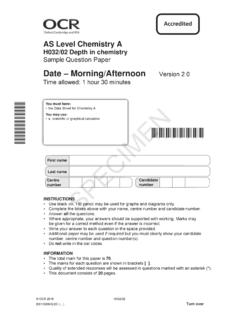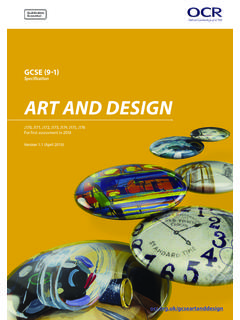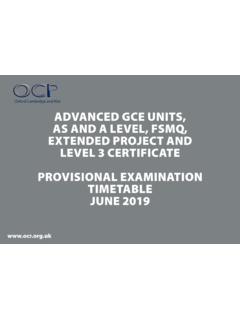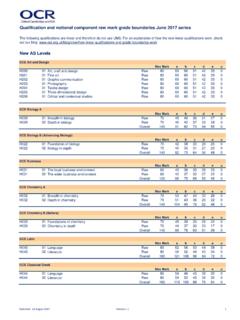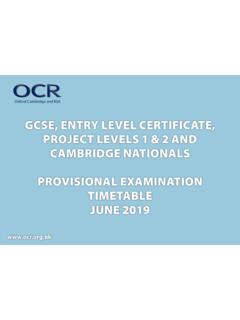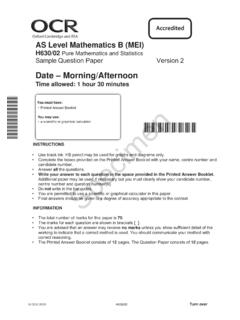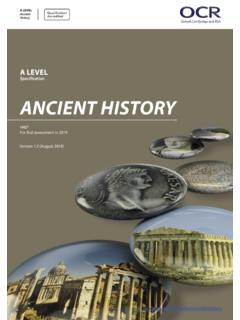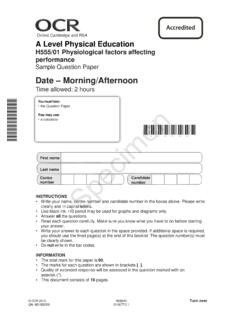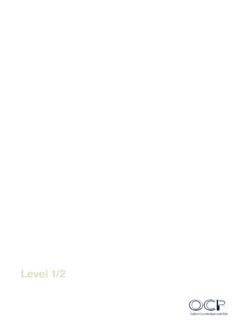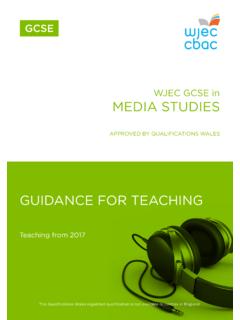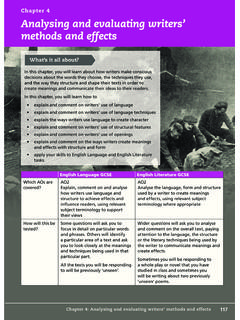Transcription of J351/J352 ENGLISH LANGUAGE AND ENGLISH …
1 GCSE (9 1). Delivery Guide J351/J352 . ENGLISH LANGUAGE . AND ENGLISH . LITERATURE. Theme: ENGLISH LANGUAGE and Literature 19th century texts April 2015. We will inform centres about any changes to the specification. We will also publish changes on our website. The latest version of our specification will always be the one on our website ( ) and this may differ from printed versions. Copyright 2015 OCR. All rights reserved. Copyright OCR retains the copyright on all its publications, including the specifications.
2 However, registered centres for OCR are permitted to copy material from this specification booklet for their own internal use. Oxford Cambridge and RSA Examinations is a Company Limited by Guarantee. Registered in England. Registered company number 3484466. Registered office: 1 Hills Road Cambridge CB1 2EU. OCR is an exempt charity. GCSE (9 1). ENGLISH LANGUAGE AND ENGLISH LITERATURE. CONTENTS. Introduction Page 4. Curriculum Content Page 5. Thinking Conceptually Page 7. Thinking Contextually Page 10. Learner Resources Page 15.
3 3. Introduction Delivery guides are designed to represent a body of knowledge about teaching a particular topic and contain: KEY. Content: a clear outline of the content covered by the Click to view associated resources delivery guide; within this document. Thinking Conceptually: expert guidance on the key concepts involved, common difficulties students may have, approaches to teaching that can help students Click to view external resources understand these concepts and how this topic links conceptually to other areas of the subject.
4 Thinking Contextually: a range of suggested teaching activities using a variety of themes so that different activities can be selected that best suit particular classes, learning styles or teaching approaches. If you have any feedback on this Delivery Guide or suggestions for other resources you would like OCR to develop, please email 4. Curriculum Content In studying GCSE ENGLISH LANGUAGE , candidates will need to be able to show that they understand writers' meanings and purposes by responding to thematically linked unseen texts or extracts.
5 In Component 1, Communicating information and ideas, one of the texts is drawn from a 19th century non-fiction source. This may include different types of journalism, travel writing, autobiography and persuasive texts such as speeches. AO1 Candidates should be able to: identify and interpret explicit and implicit information and ideas select and synthesise evidence from different texts. AO2 Candidates should be able to: explain, comment on and analyse how writers use LANGUAGE and structure to achieve effects and influence readers, using relevant subject terminology to support their views.
6 AO3 Candidates should be able to: compare writers' ideas and perspectives, as well as how these are conveyed, across two or more texts. AO4 Candidates should be able to: evaluate texts critically and support this with appropriate textual references. 5. Curriculum Content In studying GCSE ENGLISH Literature, students will study one 19th century novel from a choice of five. AO1 Candidates should be able to: read, understand and respond to texts. Students should be able to: maintain a critical style and develop an informed personal response use textual references, including quotations, to support and illustrate interpretations.
7 AO2 Candidates should be able to: analyse the LANGUAGE , form and structure used by a writer to create meanings and effects, using relevant subject terminology where appropriate. AO3 Candidates should be able to: show understanding of the relationships between texts and the contexts in which they were written. 6. Thinking Conceptually This delivery guide looks at the crossover potential when delivering the ENGLISH LANGUAGE and Literature GCSEs by spotlighting links between the 19th century set texts that form part of the GCSE ENGLISH Literature course and non- fiction mined from that era.
8 The guide comprises activities in which 19th century essays, diaries and memoranda are employed for a dual purpose: to hone students' LANGUAGE analysis skills and to contextualise the 19th century fiction being studied. Your students could begin this exploration of texts by picturing a forest where lush vegetation grows. The plants and trees they see are the themes that recur through time - in fiction and non-fiction. The themes that we're stuck on and grapple with endlessly: fear of invasion, our jitters when scientific frontiers are breached, marriage and dual identity.
9 Themes that 19th century texts are shot through with. These themes are explored in conversation, in literature, The seams represent different evolutionary stages, the skewed in newspapers, music and film until seemingly definitive and clear-sighted perspectives of both real and fictional solutions or interpretations flower. But they date as more characters on invasion, marriage, scientific advance and dual enlightened or conservative thought encroaches; as dumbed- identity, all fossilised and caught for posterity in these seams down or more sophisticated or more fashionable riffs on a of coal.
10 Theme catch on instead. It probably looked like Robert Louis Tell your students to imagine mine shafts drilled beneath Stevenson had dual identity nailed when The Strange Case of each of the trees in the forest, down which they will descend Dr Jekyll and Mr Hyde was published in 1886. But Beyonc and through the different seams, each one full of all the fiction and her alter-ego Sasha Fierce, the Incredible Hulk and internet non-fiction, the music and film that the theme inspired during trolls are channelling rebooted versions of the theme too.
